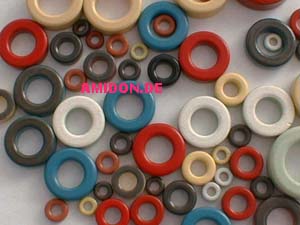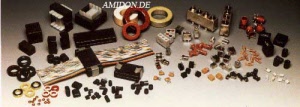 |
Amidon-English
Herzlich Willkommen auf unsere Home Page.
Ferrit-Ringkerne Ferrit-Ringkerne sind in zahlreichen Größen von 2,5 mm bis 127 mm Außendurchmesser und mit Permeabilitäten von =20 bis mehr als =10.000 lieferbar. Sie eignen sich ausgezeichnet für eine Reihe von Anwendungen im Bereich von HF-Schaltkreisen, und ihre relativ hohe Permeabilität ist besonders nützlich, um hohe Induktivitäten mit möglichst kleiner Windungszahl zu erreichen.Es gibt zwei Hauptgruppen von Materialien: die Gruppe mit einer Permeabilität zwischen =20 und =800 enthält in der Regel Nickel-Zink-Typen, während im Bereich zwischen =800, =5000, = 10.000 u. =15.000 allgemein Mangan-Zink-Typen verwendet werden.Nickel-Zink-Ringkerne weisen einen hohen Volumenwiderstand und eine mäßige Stabilität auf, bieten aber hohe Güten im Frequenzbereich von 500 kHz bis 100 MHz. Die sind für Anwendungen in Resonanzkreisen mit geringer Leistung und - wegen ihrer hohen Permeabilität - besonders gut zur Anfertigung von Breitbandübertragern geeignet.Die Mangan-Zink-Ferritkerne mit Permeabilitäten von =800 bis =15.000 haben einen recht niedrigen Volumenwiderstand und eine mittlere Sättigungsflußdichte. Sie bieten hohe Güten zwischen 1 kHz und 1 MHz. Kerne aus dieser Materialgruppe werden auch verbreitet für Transformatoren in Schaltnetzteilen eingesetzt, die mit 20...100 kHz Schaltfrequenz arbeiten. Ihre steile Sättigungscharakteristik erlaubt den Einsatz in Transformatoren, die mit Eigensättigung arbeiten. Sie können aber auch ungesättigt betrieben werden, wenn Pulsmodulations-Schaltkreise die Schaltfunktion übernehmen.Die AL-Werte sind auf den nächsten Seiten zu finden. Sie sind im Gegensatz zu den Eisenpulver-Materialien in der Einheit nH/Wdg2 angegeben. Diese Einheit ist übrigens zahlenmäßig identisch mit der Einheit mH/(1000 Wdg.)2, die gelegentlich auch zu finden ist.Sie können diese AL-Werte und die untenstehende Formel benutzen, um die Windungszahl für die gewünschte Induktivität zu berechnen. Mit Hilfe der Drahttabelle sollte dann geprüft werden, ob die benötigte Windungszahl auf den ausgewählten Kern paßt. FORMEL--- siehe..................© 1996 - 2007 Amidon.deAll Rights Reserved----------------------------------------------------------------------------------- FERRITE MATERIALS MATERIAL 33 (µ = 850)A manganese-zinc material having low volume resistivity. Used for low frequency antennas in the 1 KHz to 1 MHz frequency range. Available in rod form only.MATERIAL 43 (µ = 850)High volume resistivity. For medium frequency inductors and wide band transformers up to 50 MHz. Optimum frequency attenuation from 40 MHz to 400 MHz. Available in toroidal cores, shield beads, multi-aperture cores and special shapes for RFI suppression.MATERIAL 61 (µ = 125)Offers moderate temperature stability and high 'Q' for frequencies 0.2 MHz to 15 MHz. Useful for wide band transformers to 200 MHz and frequency attenuation above 200 MHz. Available in toroids, rods, bobbins, and multi-aperture cores.MATERIAL 63 (µ = 40)For high 'Q' inductors in the 15 MHz to 25 MHz frequency range. Available in toroidal form only. Is being replaced by the 67 material.MATERIAL 64 (µ = 250)Primarily a bead material having high volume resistivity. Excellent temperature stability and very good shielding properties above 400 MHz.MATERIAL 67 (µ = 40)Similar to the 63 material. Has greater saturation flux density and very good temperature stability. For high 'Q' inductors, (10 MHz to 80 MHz). Wide band transformers to 200 MHz. Toroids only.MATERIAL 68 (µ = 20)High volume resistivity and excellent temperature stability. For high 'Q' resonant circuits 80 MHz to 180 MHz. For high frequency inductors. Toroids only.MATERIAL 73 (µ = 2500)Primarily a ferrite bead material. Has good attenuation properties form 1 MHz through 50 MHz. Available in beads and some broadband multi-aperture cores.MATERIAL 77 (µ = 2000)Has high saturation flux density at high temperature. Low core loss in the 1 KHz to 1 Mhz range. For low level power conversion and wide band transformers. Extensively used for frequency attenuation from 0.5 MHz to 50 MHz. Available in toroids, pot cores, E-cores, beads, broadband balun cores and sleeves. An upgrade of the former 72 material. The 72 material is still available in some sizes, but the 77 material should be used in all new designs.MATERIAL 'F' (µ = 3000)High saturation flux density at high temperature. For power conversion transformers. Good frequency attenuation 0.5 MHz to 50 MHz. Toroids only.MATERIAL 'J'/75 (µ = 5000)Low volume resistivity and low core loss from 1 KHz to 1 MHz. Used for pulse transformers and low level wide band transformers. Excellent frequency attenuation from 0.5 MHz to 20 MHz. Available tin toroidal form and ferrite beads as standard off the shelf in stock. Also available in pot cores, RM cores, E & µ cores as custom ordered parts with lead time for delivery.MATERIAL K (µ = 290)Used primarily in transmission line transformers from 1.0 MHz to 50 MHz range. Available from stock in a few sizes in toroidal form only.MATERIAL W (µ = 10, 000)High permeability material used for frequency attenuation from 100 KHz to 1 MHz in EMI/RFI filters. Also used in broadband transformers. Available in toroidal form from stock. As custom ordered parts for pot cores, EP cores, RM cores.MATERIAL H (µ = 15, 000)High permeability material used for frequency attenuation under 200 KHz. Also used in broadband transformers. Available in toroidal form only.© 1996 - 2007 Amidon.deAll Rights Reserved
